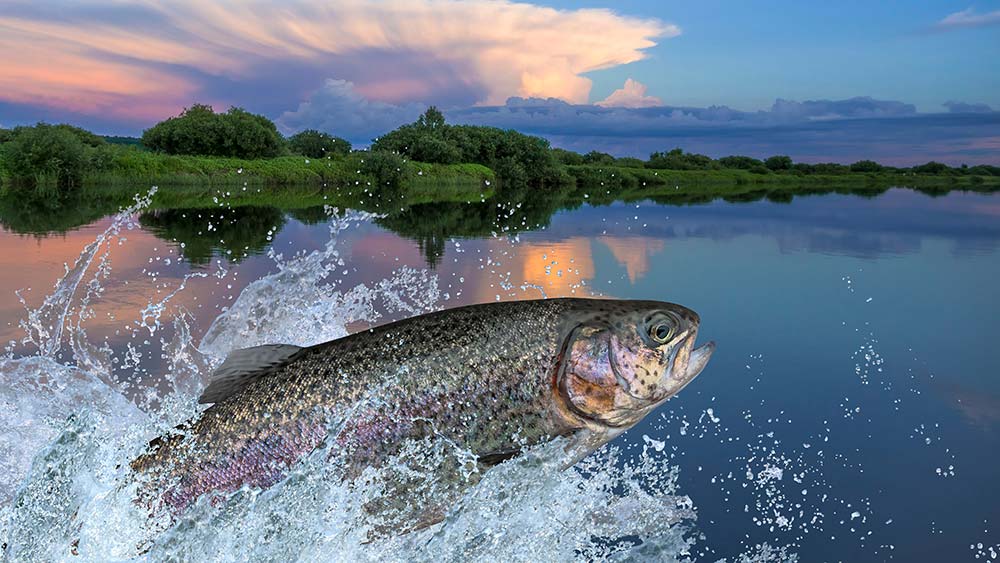
Salmon is very popular due to high levels of omega-3 fats, right? And who has never eaten a tuna salad sandwich in their life? But what real nutrients remain in fish and other seafood by the time we eat them … and is this food still safe?
In our nutritional worldview fish is a virtually unimpeachable protein source. But is this really the case?
Many of us were introduced to fish as a Friday tradition. And who can forget the breaded and deep-fried fish sticks that were standard in school lunch programs? Still others have been turned off to fish from having it served up overcooked to a fibrous cardboard texture that makes it difficult to swallow.
Can it get any more disgusting?
Still, most health-conscious people have been conditioned to believe in fish as a healthy animal protein option. But there are many things to consider before eating the “catch of the day.”
Many people choose fish because of the healthy fats, right? Well, not so fast there, Charley Tuna. While fish industry claims that wild fish and other seafood, frozen or cooked, causes minimal loss of the health-protective omega-3 fatty acids, this may be far from the truth. The science shows that once a fish leaves the water, sometimes weeks or months by the time we eat it, these vital fats quickly degrade, with little of these unstable omega-3 fats remaining.
The specific fats we’re referring to are the famous polyunsaturated omega-3 fatty acids, EPA and DHA. While both work closely together, sometimes converting to the other as needs change, especially in the brain, they are quite unstable compared to their cousins, the monounsaturated and saturated fats, also found in fish — and which are not damaged by air, light or temperature.
However, omega-3 oils are not stable to heat, oxygen (air) and light during processing, storage or cooking. Researchers found that up to 85 percent of the EPA-DHA omega-3s were destroyed in the frying process, with canning and microwaving destroying high amounts too. Light cooking destroyed the least EPA and DHA, with raw fish having the highest amounts depending upon their freshness.
While most wild seafood contains some omega-3 fats, herring, sardines, anchovy, and mackerel are among the highest sources, However, these four omega-friendly fish are also the least liked and consumed compared to salmon and tuna.
Salmon, with more than a decade of heavy healthy marketing, and tuna (a favorite for generations as the standby sandwich), may be the most popular fish. However, shrimp, a crustacean, is more popular than both fish.
Like other foods, smoking is one of the oldest ways to preserve fish. It is a process of using salt and smoke components. As popular as smoked fish may be, this process also destroys a significant portion of omega-3 fat.
Cook It?
How much can you cook fish before the valuable omega-3 fats and proteins are destroyed? In short, if you smell your fish cooking you may have crossed the line to overcooking, with a significant loss of EPA. That’s because the membranes break down even at moderate temperatures, leaking out the oil and damaging those precious fats.
Cooking temperatures and their effects
122°F (50°C): The protein myosin in meat begins to denature
131°F (55°C): Highest survival temps for harmful food-borne bacteria
132°F (56°C): Optimal cooking temps for meat
140°F (60°C): Upper limit of fish doneness.
150°F (65°C): The protein actin in meat begins to denature
While we know fish is high in protein, much of it may be damaged during cooking. Protein is denatured between 120–160°F (49–71°C). Denaturing is a disruption of the protein by higher temperatures, and in addition to affecting its nutritional value it also can significantly influence taste and texture.
While it may be best to use a thermometer to ensure food safety and avoid overcooking, experience really matters in finding this optimal window of doneness. Remember, you can taste it to see if it is properly cooked before serving. You can always cook it more as necessary — but you cannot un-cook fish if you leave on the heat too long.
Fish Safety
Of course, our oceans and other waterways have excess levels of toxic pollutants which find their way into the fish and other living things. The longstanding recommendation that women who are pregnant, plan to become pregnant or are breast-feeding, and young children, should avoid eating fish due to the risk of mercury contamination should be concerning to everyone. There are also suggestions that other types of fish be eaten in limited amounts. For example, larger species like tilefish, swordfish and king mackerel live longer, so these fish accumulate more toxins over their lifetimes. Medium-sized fish like blue-finned tuna that also live in the oceans, being safer.
Smaller fish and other seafood that live near the shores and scavenger species, sometimes called bottom feeders, are more-susceptible to ingesting a wide range of pollutants that are toxic to humans. Shellfish in particular can be high in pollutants. From medicines and motor oil to fertilizers and microbes, from run-offs, spillage and other sources (legal or not), find their way into our waterways, they may consumed by near-shore sea animals. (These animals may also be eaten by larger animals who then accumulate their toxins.)
Parasites
Another potential issue with fish is parasites and bacteria. These are two primary dangers when eating uncooked fish, and a reason to cook them at 131-140°F (60°C) to destroy that danger. In addition, freezing fish at temps of at least –4°F (–20°C) can destroy most, but not all, parasites, although not bacteria. This is a key reason most “fresh” fish sold in retail stores and served in restaurants, including sushi, has actually been frozen. Many of these fish are put into deep freeze right from the time they are caught.
Better options
Many people know there are many healthier options available for quality protein foods, such as organic eggs, cheese and meats. And for EPA-DHA, there are fish oil capsules (modern manufacturing makes it possible to distill out most harmful contaminants). Natural antioxidants such as vitamin E and rosemary extract, help protect omega-3 fish oil liquid supplements from degrading. While these liquid fish oil products last longer refrigerated, we should avoid refrigerating fish oil capsules as the cold temperatures can allow air to leak inside and can begin destroying some of the omega-3s.
Obtaining relatively fresh seafood (that’s been fresh-frozen), from a trusted source, and cooking it very lightly, while avoiding farmed fish, are the healthy choices when choosing fish. I’m less concerned that the heat destroys some of the EPA-DHA as I personally take fish oil concentrates to maintain my omega-3 levels.
References
Hădărugă DI, et al. Thermal and oxidative stability of Atlantic salmon oil (Salmo salar L.) and complexation with β-cyclodextrin. Beilstein J Org Chem. 2016; 12. doi: 10.3762/bjoc.12.20.
Bienkiewicz G, et al. Changes in the EPA and DHA content and lipids quality parameters of rainbow trout (Oncorhynchus mykiss, Walbaum) and carp (Cyprinus carpio, L.) at individual stages of hot smoking. Heliyon. 2019;5(12):e02964. doi: 10.1016/j.heliyon.2019.e02964.
**
https://www.oreilly.com/library/view/cooking-for-geeks/9781449389543/ch04.html








